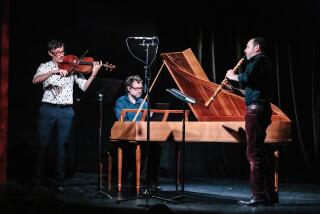Review: Midori reaches soulful new heights with Bach at Hahn Hall
SANTA BARBARA — Midori is a formal and famously unflappable violinist. I don’t know whether she is fearless, but she may be that too. She came to our attention at age 14 in 1986 as a soloist for Leonard Bernstein in his “Serenade.” She broke two strings during the performance, but nothing fazed her. Bernstein bowed to her afterward in awe.
She’s as committed a musician as you will find. She never lets an audience down. But there can be a downside to her dedication and her striving for perfection. She could seem a little too dutiful.
Monday night she played the first of two recitals at Hahn Hall, the intimate recital venue of Music Academy of the West, in which she will traverse Bach’s six Sonatas and Partitas for solo violin. This is the Everest for violinists, a test of fingers and feeling, and here she reached such new heights. I found myself on the long ride home afterward with what felt like the first signs of altitude sickness, driving with the widows open and gulping down air.
TIMELINE: Summer’s must see concerts
This first program contained the first and third sonatas and concluded with Partita No. 2 in D Minor, with its famous Chaconne conclusion, performed without intermission over a 69-minute stretch. Midori probably has been playing that Chaconne since she was a toddler and used it to audition at Juilliard while still a child.
I thought I had an idea of what to expect Monday, and that would be sober, musically flawless, unimpeachably proportioned Bach, enhanced by her plush tone, as can be heard in the sensitive but not overpowering recording of the D-Minor Partita she made in 2006. The music, the violin, Bach and that’s all, presented in an acoustically immediate space. If I had been right, I would have left, I’m sure, gladdened.
But I was clearly wrong. It has taken a long time for Midori to put herself into her music the way she did Monday. She is from everything I’ve read over the years, an unsatisfying interview. She says nothing about herself and little of substance, offering only platitudes. We haven’t a clue as to what makes her tick.
FULL COVERAGE: 2013 Spring arts preview
Monday something came pouring out of Midori. The violin playing was still phenomenal. Her sound filled every inch of the hall. But that, I don’t think, is what held the audience so spellbound. I didn’t notice a single cough or rustle. Even German audiences aren’t normally that attentive.
There are endless theories about these revered sonatas and partitas, such as the progression through them from darkness to light. They have been said to contain the very soul of the violin like no other music before or in the three centuries since Bach wrote them.
I subscribe to other theories about Bach, that he was essentially being a spirited craftsman here, delighted to show his amazing technical craft, such as his capacity to write complex counterpoint for a single instrument. These pieces were written for connoisseurs to learn and share, not to hypnotize a future public in Hahn Hall.
The soulfulness is what we now seek and certainly what Midori so significantly added. The sonatas begin with slow adagios, experiments in harmony and form, with hidden structures. Midori has taken an interest in modern music in recent years, and that may have had something to do with why she played Bach as if the ink were still wet and she didn’t know where the movements were headed. She mined notes like an archaeologist on a dig to see what they might reveal.
PHOTOS: Arts and culture in pictures by The Times
Fugues follow. Here Midori became like a powerful builder, creating massive structures. Her tone was very thick, and she didn’t seem to care about detailing the fugues’ inner structures that Bach built and which are so exceptional. She revealed great vistas, the reasons for the structures were her own but also true to Bach. The experience was aural but the vision was immense.
She used the slow third movements to slow time, entering the inner world of the violin. The final fast movements were to speed time with nuclear propulsion.
The partita was different. The movements use dance forms and Midori moved physically as she played more than was once her wont. Again she didn’t concentrate on where the music came from but where it was going. The D-Minor Partita flowed, within movements and from one movement to the next, like a river breaking off into deltas.
The imposing Chaconne has become a showpiece, but she didn’t treat it as one. Rather, she rode its rapids. The point wasn’t to control the rush of waves or sound but to become one with the force so that you could celebrate everything around you.
Midori is 42, in early maturity. We can’t possibly know where she is headed. But there can be no question she has arrived. Wednesday, at the Hahn, she will finish the Bach cycle.
More to Read
The biggest entertainment stories
Get our big stories about Hollywood, film, television, music, arts, culture and more right in your inbox as soon as they publish.
You may occasionally receive promotional content from the Los Angeles Times.











